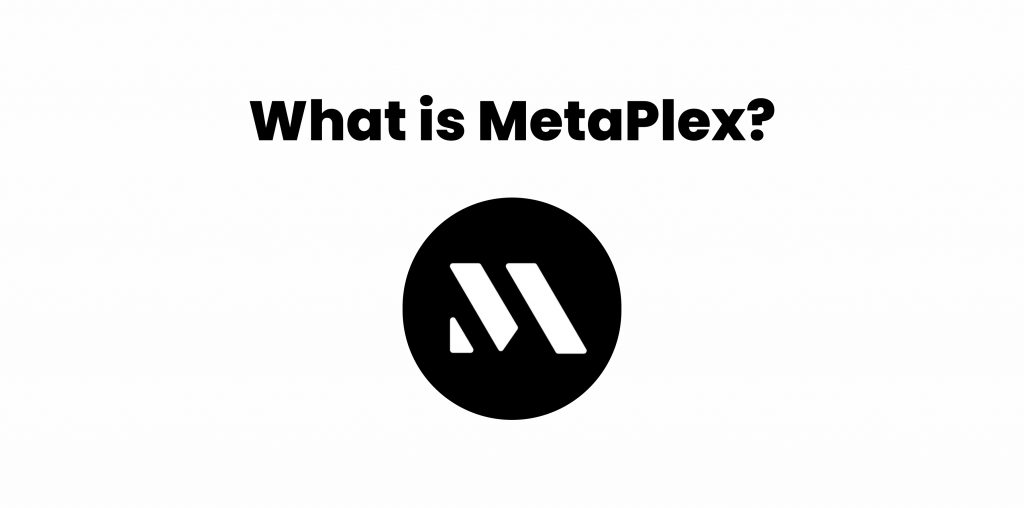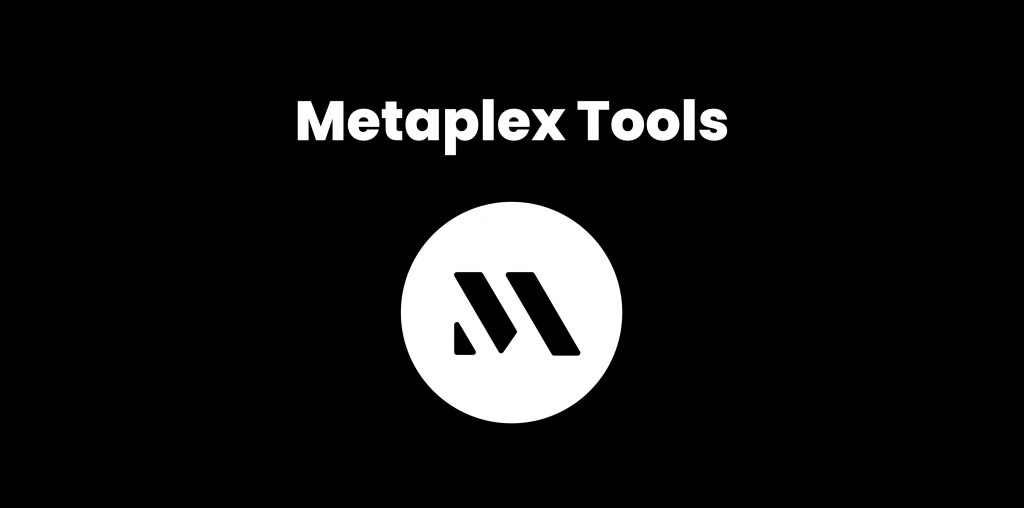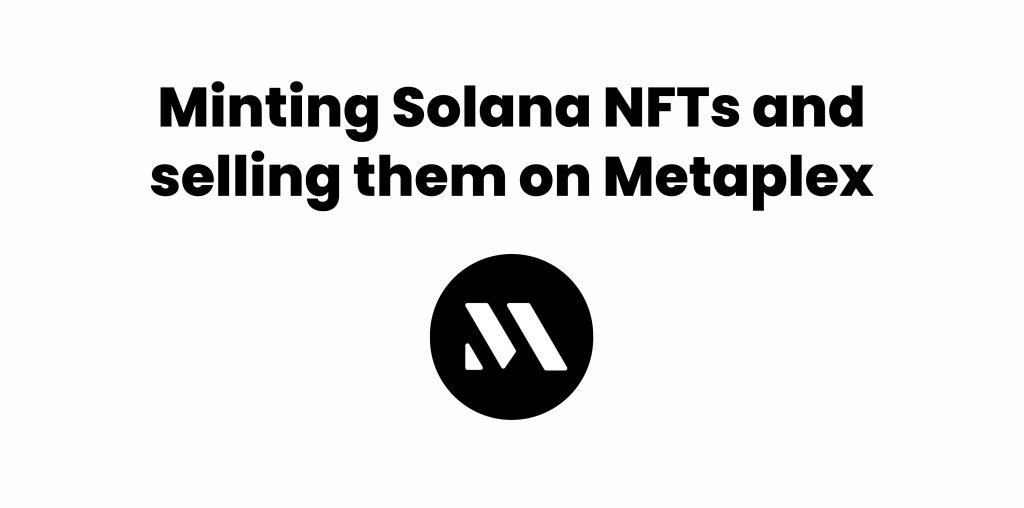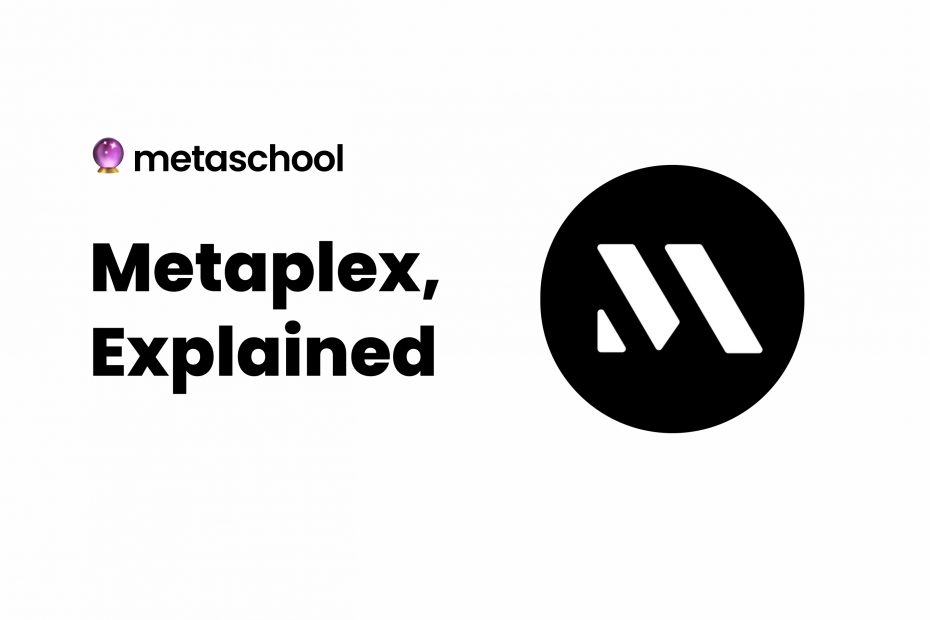Table of Contents
Introduction to Metaplex
Metaplex is a Solana-powered framework and protocol that developers can use to create, mint NFTs, and launch their own collections. It is said to be the fastest-growing platform for NFT collectibles.

Contrary to commonplace Solana-based marketplaces, Metaplex works more as a library of tools and smart contracts that can be used to create customizable NFTs more flexibly.
It is like a framework for the creation, minting, and management of NFTs. Therefore, it should not be confused with a platform like Magic Eden, which is merely a Solana-based decentralized marketplace that allows users to buy and sell NFTs online.
It comprises of four smart contracts – Auction, Metaplex Program, Token Metadata, and Token Vault – and three tools – Metaplex Storefront, Candy Machine v2, and Gumdrop.
But before this blog delves deeper into understanding what Metaplex is, it is vital to understand some key terms mentioned below:
What is an NFT marketplace?
An NFT marketplace, as the name suggests, is basically an online digital assets platform where you mint, sell, buy and exchange NFTs.
And what exactly is Solana?
Solana is a Layer-1 decentralized blockchain. It follows the proof-of-history (PoH) consensus mechanism and is said to be one of the most scalable, fast, and secure blockchains in the world today.
It is so fast that it claims to have a throughput of some 3000 transactions per second (TPS). The strong features and characteristics it comes with make it a good fit and a first choice for decentralized finance (DeFi) and decentralized gaming.
Also, how should one define NFTs?
NFTs stand for Non-Fungible Tokens. These are tokens that cannot be copied or replicated, unlike fungible tokens. These types of tokens are the most prevalent in the web3 ecosystem.
Even those who’ve never created one have heard of it. That’s because they can be inspired by art, a character, or a widget from a popular game or they could be something you’ve never seen in your life. But there can only be one of them. Unique properties like these make sure they can be bought, sold, or exchanged.
Why should one create a marketplace on Solana?
Because Solana is a high-performance blockchain protocol known for its fast transaction processing and scalability, it is an attractive choice for creating dApps and marketplaces. Some key characteristics and advantages of a Solana-based marketplace are mentioned as follows:
1. Fast transaction & low gas fee
As mentioned, Solana is known for its fast transactions and low gas fees in comparison to its counterparts such as Ethereum, which is congested. This naturally makes it an ideal choice for hosting and deploying NFT marketplaces and minting NFTs. Compared to the Ethereum Blockchain’s gas fee, Solana’s is very low (a few cents). Low gas fees mean more transactions at a faster rate of transaction.
2. Widespread community
The power of community is often talked about. When a community is rapidly growing with new and young people with great ideas, there is extensive innovation in different fields.
Solana, as an emerging blockchain, is host to a strong community and becomes home to new users and developers every single day. This means more innovation, growth, and creativity in the NFT space.
3. Interoperability
Interoperability is yet another interesting feature of Solana. Almost all Solana-based marketplaces are very much compatible with Solana-based applications and smart contracts. Thus, the inter-transferability of NFTs is hassle-free in Solana.
Moreover, Solana is supported by various software wallets (Math wallet, Trust wallet, Atomic wallet) and hardware wallets (Trezor, Ledger Nano X, D’Cent) as well. Additionally, Solana can interact with other blockchains such as Ethereum, Terra, BSC, etc., and also supports token bridging.
4. Security and reliability
Solana, as a blockchain, is inherently designed to ensure the security and integrity of data and transaction records. It follows the PoH consensus mechanism which greatly helps in preventing double-spending and other malicious activities within the blockchain, providing a safe and secure environment to those visiting or running Solana-based marketplaces.
5. Customizability
Lastly, Solana-based marketplaces also enhance and leverage a user’s inner creativity. This is why the blockchain equips you with tools and provides you the freedom to customize your marketplace. You can design your own unique experiences, have the best trading mechanisms to enhance the overall user experience, and positively influence your target audience by meeting their needs.
How do Metaplex smart contracts work?
Now that you know about Metaplex, marketplaces, Solana and NFTs, let’s go a step further.

So, what do the protocol’s built-in smart contracts do? As mentioned earlier on, Metaplex has four Solana-based smart contracts that make the creation, launch and trading of NFTs easier.
The smart contracts work together within the ecosystem to give a seamless and smooth experience to creators, collectors, and developers. These Solana-based contracts also have different functionalities which make the whole NFT creation process secure, efficient, and easy. The contracts are as follows:
1. Token Metadata
Token Metadata is one of the most useful smart contracts. It is majorly responsible for storing and providing metadata to NFTs minted on the platform. Metadata includes information like name, symbol, royalty fee, and the sold status of the NFT. This metadata is crucial for displaying and presenting NFTs accurately on the storefronts.
Compared to other ways of attributing metadata to tokens, Metaplex’s Token Metadata is unique in some key ways. Metadata has a very specific smart contract structure and standard defined by the marketplace’s protocol. This means that all tokens minted on the platform have uniformity that can show that they are Metaplex tokens.
Similarly, Token Metadata tends to have more information than the usual name and description of the token. All in all, this particular smart contract ensures that there is a unique identity of tokens minted on this platform which standardizes the tokens.
2. Token Vault
Token Vault is yet another important smart contract. This program is made to safely store and manage deposited NFTs.
But how does that work? Well, when you mint an NFT, it first goes to the vault with the help of the smart contract. The NFT remains there until it is sold, exchanged or transferred to a user. Token Vault is an efficient mechanism for the management of freshly minted NFTs. The contract ensures the safekeeping of NFTs until they are moved or traded.
3. Auction
Auction, as a smart contract, enables the organization and management of auctions and NFT pre-sales on the Metaplex platform. It handles the bidding process, time limits, and the transfer of ownership when an auction is concluded. This contract allows creators to run auctions and collectors to participate in them.
4. Metaplex
It can be considered the primary smart contract as it serves as it holds together the core infrastructure of the Metaplex protocol. Metaplex has various functionalities such as the minting of NFTs, managing the Token Metadata contract, enabling royalty payments, and facilitating marketplace transactions. It also acts as the central point of coordination for the other smart contracts. It can be considered as a binding force.
Benefits of Metaplex
In the year 2022, it is believed that 78% of Solana NFTs were minted using the Metaplex protocol. This is primarily because the platform has multiple benefits which attract developers and builders alike. The reasons why it is attractive are as follows:
- Open source
- Free to use
- Has limitless creation of customized NFT experiences
- Ensures wide support
- Has control over royalties
- Is much faster and less expensive than Ethereum-based NFT platforms
Important Metaplex tools and how they work
While smart contracts are the heart of Metaplex, the tools mentioned below are its backbone. Assuming that the smart contracts have already hyped your inner NFT creator and collector, here are some that you must know about.

1. Metaplex Storefront
The Storefront is an interesting and useful tool and project. It is an all-in-one NFT marketplace that you can use and utilize to create, sell and showcase NFTs.
There are two options to use the Storefront. The first option is to self-host it as a white-label solution and the second option is to use the branded storefronts that already exist. If there is a feature that truly allows users and developers to unleash Solana’s decentralization, it has to be the Storefront.
Uses and features
- It helps with NFT creation
- Gives users and developers alike the opportunity and creative freedom to customize and create their own Storefronts
- Its feature of Fractional Ownership helps users to divide shares and invest to ensure that the Storefront is fully owned
- Given how the four Solana-based contracts (Auction being one of them) are an integral part of Metaplex, the Storefront also allows auctions and sales
- The Storefront is also quite developer-friendly which is yet another important feature
Hosting a Metaplex Storefront
When it comes to hosting a Storefront, there are a few easy steps that you can use as a developer:
- Since Metaplex has provided all the sources and documentation, you can simply copy the Storefront source code and copy it on GitHub
- Now switch the local host Solana network to Devnet
- Kickstart the Storefront by clicking “Init Store” and approving the transaction
- In the Store configuration section, copy the code and paste it into the .env file located in js/package/web
- Restart the website with yarn start and voila!
2. Candy Machine v2
Candy Machine v2 has a two-pronged approach. It is a program that creates NFTs on Metaplex using computer algorithms. Think of it as Enjin or PixelChain. And later, it provides a seamless and smooth experience to NFT buyers and sellers. Thus, it works as a distributor as well. This is also why it is called Metaplex’s generative NFT distribution program.
Candy Machine v2 is the second iteration and version of Candy Machine with enhanced features and better performance. It also has an alternative now which happens to be better in performance and is called Sugar.
Uses and features
- It sets a precise minting time for NFTs
- Only accepts funds and amounts from buyers when the NFTs can be minted, keeping up with transparency and maintaining trust
- One of the features also involves whitelisting
- Has a special method that prevents bots from minting NFTs
- There is consistency in the NFTs because Candy Machine enforces metadata types
To get started with using this project, you may check out this thorough and extensive tutorial and follow the lead to launch your own NFT collection on Solana using Candy Machine v2.
3. Gumdrop
Gumdrop is a new tool for Solana airdrop which is the distribution of free Solana tokens to the users of the blockchain. Airdrops are used by platforms and projects as a way to reward and engage a community. What Gumdrop does essentially is that it provides an easy solution for projects to distribute Metaplex tokens at a cheap cost.
The tool supports token airdrops, Candy Machine pre-sales, and edition prints. Gumdrop leverages the Merkle tree formula to carry out airdrops. This Merkle tree chooses from whitelisted users and distributes claim links in an off-chain manner.
Minting Solana NFTs and selling them on Metaplex
Now that you know that Metaplex utilizes and uses tools and Solana-based contracts to help developers mint NFTs, and maintain and manage their storefronts, you would want to know how you can mint NFTs on Metaplex. Not just minting, you would also want to practically use and get acquainted with Metaplex tools and projects such as Candy Machine, Gumdrop, etc.

Well, here are some general steps that you can follow to mint Solana NFTs using the Metaplex platform:
1. Set up a Solana wallet first
The first and most important step is to interact with the Solana blockchain and the Metaplex platform. To do the needful, you can choose any Solana-supported wallet like Phantom, Solflare, etc., and create a wallet address.
2. Connect the wallet to Metaplex
You can now use the wallet address to either connect it directly to the Metaplex platform or the Metaplex Storefront. This connection shall enable you to interact with smart contracts along with minting and selling the NFTs.
3. Now mint your NFT
Now that your wallet is connected to Metaplex, you can easily mint your NFTs on the platform. Here, the Token Metadata smart contract will be very useful. Once your NFT is minted, you can add necessary information to its attributes such as name, description, etc.
4. Set a royalty fee
Once your NFT is ready, you would want to sell it. Therefore, make sure to set a specific royalty fee. The average royalty fee for NFTs set by creators is usually around 5% to 10%. Royalty fee ensures that the original creator of an NFT gets some compensation whenever the NFT is sold and resold.
5. Put your NFT for sale
Once the token is minted, metadata is attributed, and the royalty fee is set, you can list the NFT for sale on the Metaplex Storefront. Using the Auction smart contract, you can set prices and enable auctions for your NFTs.
6. Start promoting your NFT
Once the NFT is put on sale, you can begin with product promotions. Some channels that you can use to promote your NFT are Twitter, Reddit, or Discord communities with passionate NFT collectors.
To get more in-depth knowledge of how you can mint an NFT, how the Token Metadata works, etc., you can refer to this video tutorial which walks you through the intricate details of using Metaplex features and educates you on the practical implications and implementation of the ecosystem’s features and functions.
Conclusion
In conclusion, Metaplex is a rare protocol with so much falling into one place. It leverages Solana-based smart contracts and in-built tools and projects like Gumdrop and Candy Machine v2 for NFT creation and minting.
It also provides a one-stop solution for the creation of NFT marketplaces in the form of Storefronts. The Storefronts are also unique in nature for their different functions like white-labeling, ownership, auctions, pre-sales, NFT minting, and much more. Similarly, Gumdrop is an equally essential and important tool that makes Solana airdrops possible and closely ties the community together.
If you want to get to know Solana before building a complete storefront, here’s a quick (and free-of-cost) project to create a Solana token. Thanks for reading. Feel free to browse through other awesome guides written by our team.
FAQS
Who owns Metaplex?
Solana-based NFT firm Metaplex is owned by Adam Jefferies who also works as the CEO.
Does Metaplex have a token?
Yes, the Metaplex protocol does have a token. It is called MPLX and it is a community governance token.
